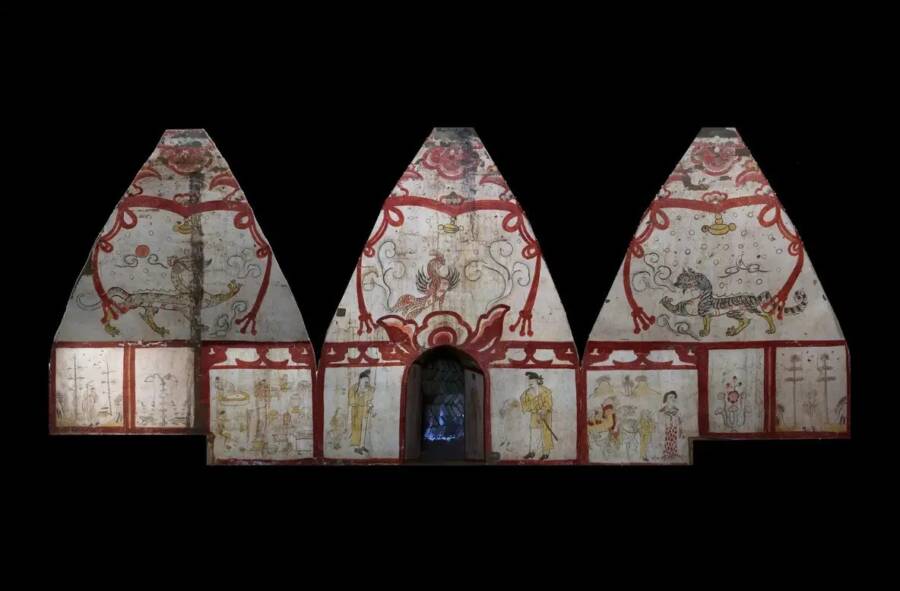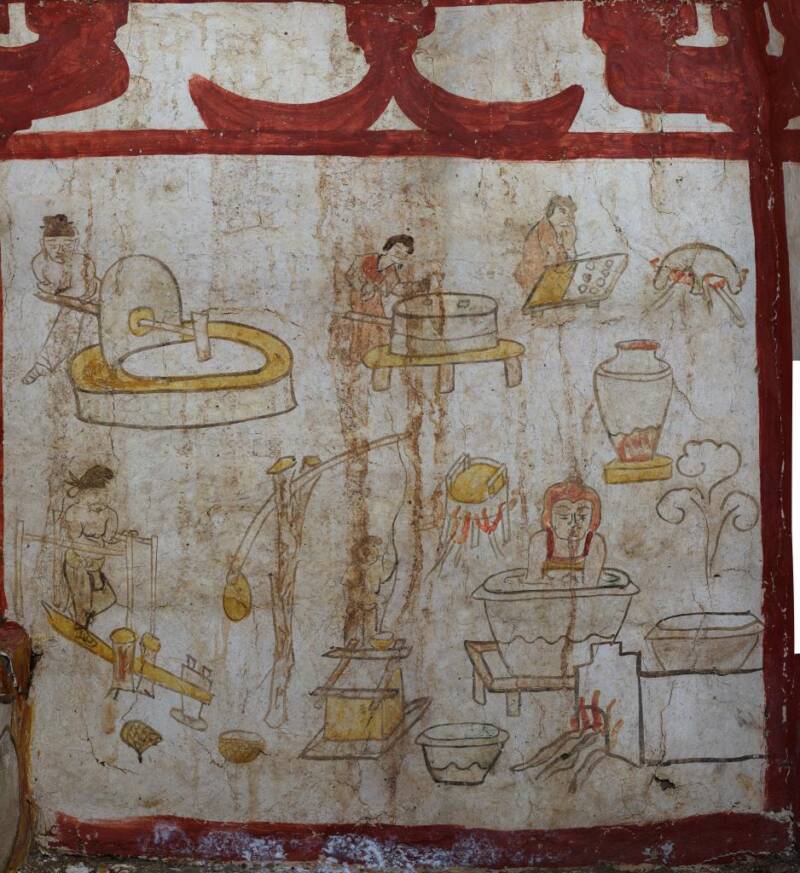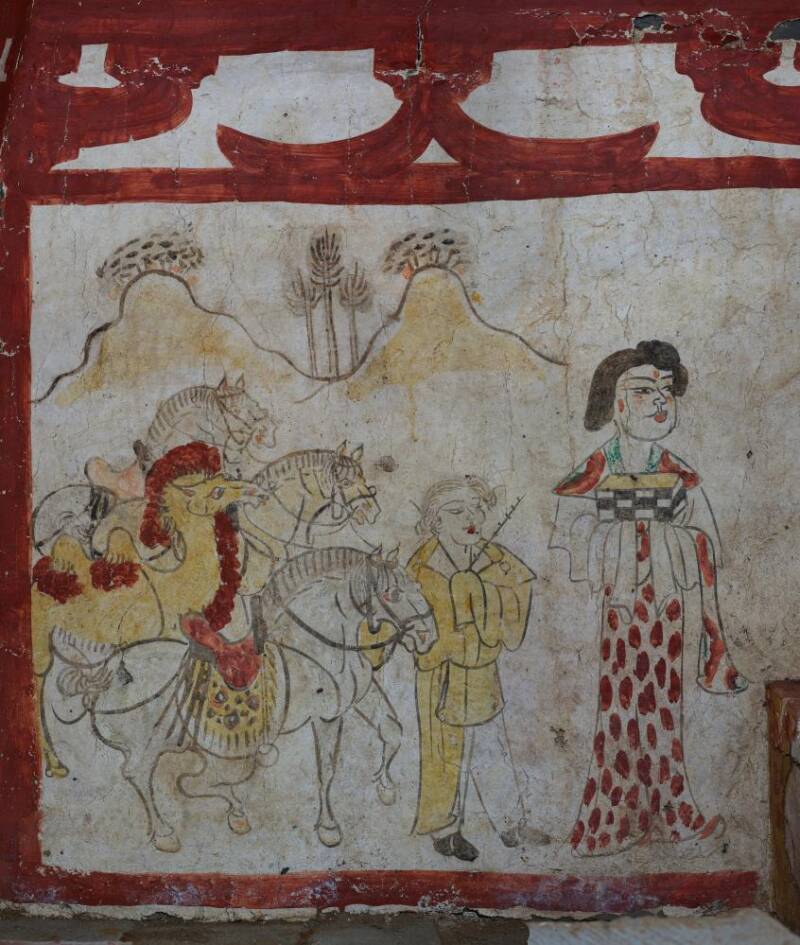Belonging to a man who died in present-day Taiyuan in 736 C.E., the tomb is adorned with a wealth of other paintings, including farmers working in their fields, sentries with swords, and several multicolored dragons.

Jinyang Ancient City Research InstituteA panoramic view of the Tang Dynasty tomb and the many murals covering its walls and ceiling.
During road construction in the Chinese city of Taiyuan, workers stumbled across a stunning centuries-old tomb from the Tang Dynasty. Subsequent excavations revealed that the tomb, probably belonging to a husband and wife, was covered with a unique set of murals.
These murals depict vivid scenes of life in the eighth century C.E., including the surprising depiction of a “Western man” with blonde hair and a beard, a type of figure not seen in other artwork of the era.
The Discovery Of The Tang Dynasty Tomb During Road Work In Taiyuan

Shanxi Provincial Institute of ArchaeologyThe entrance to the Tang Dynasty tomb, adorned with yet more paintings.
According to Chinese state media, the tomb was first discovered during construction work along old Jinci Road in Taiyuan City. Once workers realized what they had found, they notified the Cultural Relics Department, which oversaw excavations and research of the 1,300-year-old tomb.
The tomb is a single-chamber chamber tomb with a “sloping tomb passage.” The entrance is decorated with botanical designs, as well as several figures that are likely guardians or gatekeepers.
An epitaph found at the site explains that the tomb’s owner died in 736 C.E., during the Tang Dynasty, at the age of 63. He was laid to rest alongside his wife that same year.
But the most remarkable thing about the tomb is that it’s filled with murals.
As Chinese media reports, the “tomb door, corridor, four walls of the tomb chamber, tomb top, and coffin bed are all painted with murals.” These designs offer a rare look at what life was like in the region more than 1,000 years ago.

Shanxi Provincial Institute of ArchaeologyThe walls of the tomb are covered with detailed murals.
So what exactly do these striking paintings depict?
Vivid Murals Of Daily Life In The Tang Dynasty As Well As A Rare “Western Man”
The murals display a wide variety of scenes that largely appear to reflect daily life. On the southeast wall of the tomb, the murals depict a man pushing a millstone to grind grain, a woman pushing a stone mill to grind flour, a man making noodles, a man pounding rice, and a woman fetching water.

Jinyang Ancient City Research InstituteSome of the murals that line the walls of the Tang Dynasty tomb.
Over the coffin bed are eight paintings that use a “people under a tree” style that was popular in the region at the time. They show flowering plants, a man with a jade tablet, a man holding a stone, a man reaching toward a snake, a man carrying an ax, and a man holding a cup while pointing at a tree, and a plant with withered flowers.
Curiously, the murals on the southwestern wall — which depict camels and horses, mountains and trees, and a woman in a long skirt — also seem to show a man with blonde hair and a beard. Chinese media describes him as a “Hu man,” a term used to describe ancient “barbarians” from beyond the Central Plains.
Though experts remain unsure about the nature of this rare figure, they believe he may represent a Sogdian, a group from present-day Tajikistan and Uzbekistan that traded with the Chinese via the Silk Road during this era.

Jinyang Ancient City Research InstituteA mural on the southwestern wall of the tomb seems to depict a blond, bearded man who Chinese media described as a “Hu man” and believed to represent a Westerner from central Asia.
With such a wealth of murals, this tomb — lost for centuries — offers a fascinating look at what life was like some 1,300 years ago. Its domestic scenes of making food, murals of mountains and trees, and hints of interactions with foreigners help reveal the rich tapestry of life in the region at that time.
After reading about this Tang Dynasty tomb filled with murals, learn about the remarkable story of the Terracotta Army discovered in an ancient Chinese tomb. Then, read up on the tragic story of Empress Wanrong, the last empress of China.





